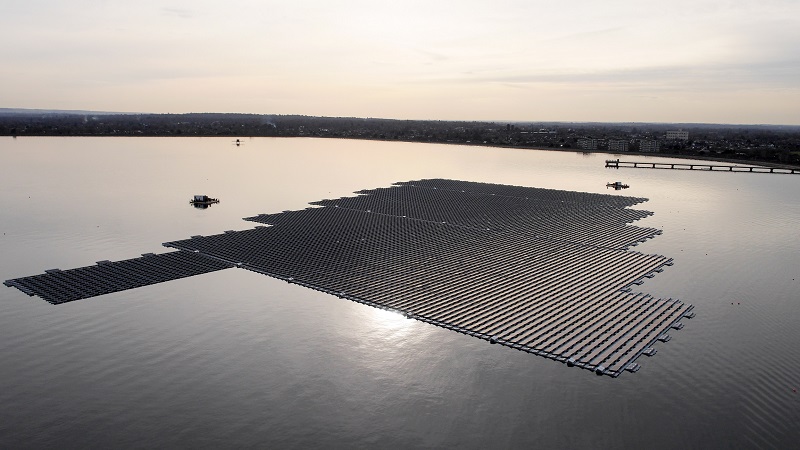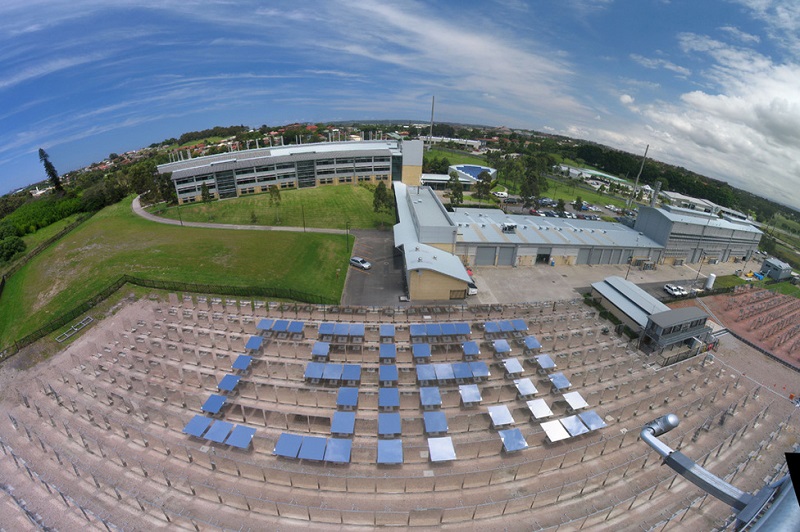All photovoltaic (PV) panels become slightly less efficient as their temperature rises, so cooling them can lead to better energy production, especially in warm climates. This is where the idea of building solar PV farms on or near water starts to look more attractive.

Is it a pool? Is it a raft? No, it’s float-ovoltaics! Credit: Photo courtesy of Lightsource
Close your eyes and ponder what a commercial solar photovoltaic (PV) farm looks like. Do you envisage arid desert plains glistening with thousands of solar PV panels under abundant sunshine?
You’re probably not alone thinking such sunny thoughts. But believe it or not, the ideal temperature conditions and landscape for solar PV panels to work most efficiently doesn’t always have to be hot and sunny weather. The amount of energy produced is often influenced by the material of the panels themselves, and recent research has unveiled that sometimes thousands of solar panels floating on water is the best way to increase energy output.
Floating a bright idea
We all know PV panels look great on rooftops, but where else can they be installed to maximise the amount of energy being produced and to utilise space? All PV panels become slightly less efficient as their temperature rises, so cooling them can lead to better energy production, especially in warm climates. This is where the idea of building solar PV farms on or near water starts to look more attractive.
Solar ideas coming up from Down Under
As is often the case, an Australian company led the way, with one of our former scientists, Phil Connor, designing the first ever floating solar PV system around a decade ago for the Australian company Sunengy Pty Ltd. We tested the first prototype of that system, which is now on the way to becoming commercialised in India.

Australian company Sunengy’s world-first large floating solar photovoltaic array, and the first installed on a hydro-electric dam.
Thinking outside the solar box
Scientists across the globe are investigating how to most efficiently build solar PV systems on water to ensure you can power-up using the sun, and enable some industries to generate enough power for their operational requirements. These floating solar farms utilise space that would otherwise go wasted and can also help reduce evaporation. Placing the collectors in a hydro dam, as Sunengy has done, gives free access to the large transmission line, allowing considerably better economy from the PV installation.
Australia first large floating solar plant was built in Jamestown, South Australia in April 2015, generating up to 45 percent more energy per panel than a rooftop solar system. The city of Lismore announced a call for tenders this year to build the first ever community funded floating solar farm.
Europe’s largest floating solar power farm was unveiled in London, UK. Built by Thames Water, the farm consists of 23,000 solar panels and will produce enough power to operate the utility’s local water treatment plants including enough clean drinking water for nearly 10,000 people. More construction for bigger and better floating solar farms are already underway.
Catching the solar floating wave
So what does this mean for Australia’s energy future, and our landscape? Will we be seeing a sea of solar farms pop up along our Aussie waterways, dams and coastlines?
One of our solar research gurus, Dr Greg Wilson, thinks floating solar farms could be the way of the future for semi-arid regions of Australia, in particular farmland and waterways for irrigation.
“Floating solar PV panels reduce evaporation so there is significant potential to create better and more efficient energy systems when used near open irrigation systems or for water treatment plants or large drinking water catchment areas,” said Dr Wilson.
“Water quality is maintained by circulation of the main body of water so the energy required for this can be offset by the energy produced by the solar panels. It can be far more energy efficient and cost effective to have reduced evaporation than purely generating electrical energy,” he adds.
Sunengy’s vision is to incorporate hundreds of megawatts of floating solar on the surface of each of our hydroelectric dams to create the lowest cost addition to our renewable energy supplies.
Looking at the Australian and international examples of floating solar farms that have emerged over the last 12 months, it’s certainly an area for growth.
We aren’t walking on water just yet but we are leaders in the solar energy space with two active solar research fields including photovoltaic and concentrating solar thermal power. We also recently challenged the status quo for energy innovation by holding our first ever Solar Hackathon.

These heliostats might not be floating on water, but they can spell our name!


30th May 2018 at 11:41 am
I am considering floating a 5kW array on my dam, as all other areas on my property are overshadowed by trees. Are there off-the-rack producers able to supply kits or installations at this kind of small-scale? Or do I have to engineer and construct this kind of thing myself?
Also, I would ideally like the array to power its own rotation, so that it it orientated most efficiently towards the sun during daylight hours and at different times of the year: this should require much less energy for a floating array than what would be required to equivalently rotate a land-based array. Computer-controlled stage-rotation machinery can be easily adapted to undertake this task, and linked to software that provides the daily azimuth settings for my (or any) location. Are you aware of any work that has been undertaken along these lines?
4th June 2018 at 4:05 pm
Hi there, Michael. Unfortunately our energy team doesn’t have any tips for you, but we might point you to the company involved: http://sunengy.com/
Jesse
CSIRO, Social Media Team
7th September 2016 at 3:39 pm
Is there any thought of combining floating solar arrays with pumped water energy storage for peak demand hydro electricity?
8th September 2016 at 3:08 pm
Hi Fallon,
We forwarded your question on to Dr Greg Wilson who has provided this response:
“I’m not aware of floating solar being used for pumped hydro storage. There are quite a few pumped hydro projects around the world with quite a few proposed or under construction that look to collocate solar PV with the pumped hydro to reduce the parasitic load for pumping. Renew Energy has a good article on this: http://reneweconomy.com.au/2016/no-batteries-needed-pumped-hydro-for-energy-storage-79785
In Australia there is a solar PV / pumped hydro storage project planned for Queensland that will look to utilise a disused mine site: http://reneweconomy.com.au/2016/kidston-pumped-hydro-storage-plant-17897”
We hope this helps!
Cheers,
Ellen
CSIRO Social Media
24th June 2016 at 4:31 pm
Regarding the practicality of large solar arrays, that is very encouraging news. I imagine that CSIRO’s work on improved battery design would also be great news to solar industries. The idea of using multiple array sites, when spread apart, would on cloudy days help smooth insolation fluctuations.
Thanks Christopher for your time.
24th June 2016 at 3:23 pm
Excellent response Christopher
22nd June 2016 at 9:48 pm
What total area of solar arrays would be necessary to replace such as Yallourn power station? Difficulties of converting electric output to provide a regular alternating current supply, reticulated over long distances, might pose serious problems.
24th June 2016 at 2:02 pm
It would be possible to produce the same peak power output as Yallourn using a solar array covering as little as 814 Ha (equivalent to a square of 2.8 km along each side). For practical reasons including topographic variation, land availability, use of lower efficiency solar panels etc., the actual area used could be up to 3 or 4 times larger (5.7 km along each side). Remember also that solar only generates its peak through the middle of the day. Yallourn probably doesn’t run at full speed all day either, so let’s double the size of our solar system and call it fair. A square of 10 km along each side should cover it easily. Yes, this might take a while to jog around, but it’s really only a small square on the map. The construction and maintenance costs would be comparable to building another Yallourn, but there would be no ongoing fuel cost.
Converting the output to alternating current isn’t a problem for the solar array, but the intermittency of the solar output is. That’s why CSIRO is working to better understand the response of solar systems to variable weather conditions.
Yallourn Power Station is rated at around 1.48 GW, so it would need a solar array about twice the size of the current world’s largest to produce the same peak output. System sizes are growing fast though, see https://en.wikipedia.org/wiki/List_of_photovoltaic_power_stations. Having said that, we may be about to see a trend toward systems that aren’t quite so big, but more of them. Spreading them around makes it easier for the electricity grid to absorb the power, and can also improve the intermittency problem too.
28th June 2016 at 9:41 pm
What size area would be required if instead of PV it was a concentrated thermal design?